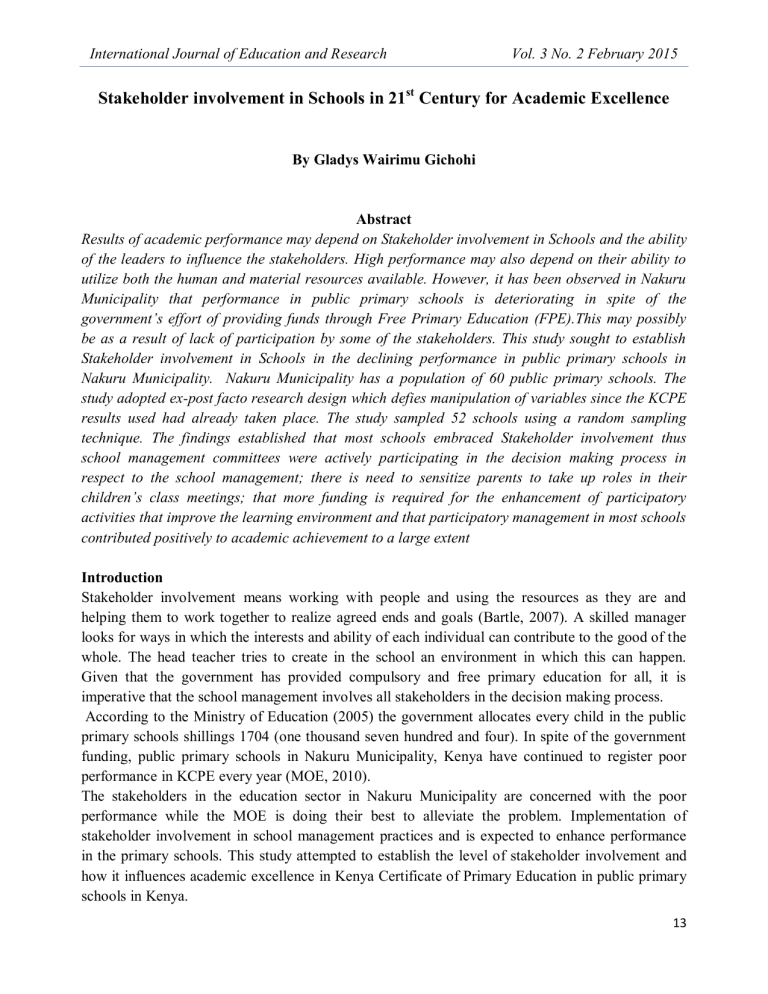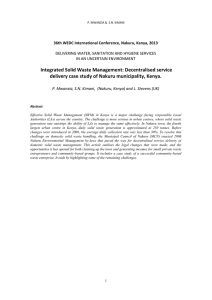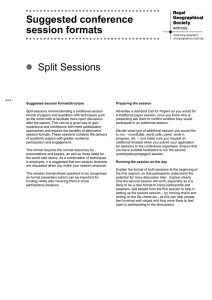
International Journal of Education and Research Vol. 3 No. 2 February 2015 Stakeholder involvement in Schools in 21st Century for Academic Excellence By Gladys Wairimu Gichohi Abstract Results of academic performance may depend on Stakeholder involvement in Schools and the ability of the leaders to influence the stakeholders. High performance may also depend on their ability to utilize both the human and material resources available. However, it has been observed in Nakuru Municipality that performance in public primary schools is deteriorating in spite of the government’s effort of providing funds through Free Primary Education (FPE).This may possibly be as a result of lack of participation by some of the stakeholders. This study sought to establish Stakeholder involvement in Schools in the declining performance in public primary schools in Nakuru Municipality. Nakuru Municipality has a population of 60 public primary schools. The study adopted ex-post facto research design which defies manipulation of variables since the KCPE results used had already taken place. The study sampled 52 schools using a random sampling technique. The findings established that most schools embraced Stakeholder involvement thus school management committees were actively participating in the decision making process in respect to the school management; there is need to sensitize parents to take up roles in their children’s class meetings; that more funding is required for the enhancement of participatory activities that improve the learning environment and that participatory management in most schools contributed positively to academic achievement to a large extent Introduction Stakeholder involvement means working with people and using the resources as they are and helping them to work together to realize agreed ends and goals (Bartle, 2007). A skilled manager looks for ways in which the interests and ability of each individual can contribute to the good of the whole. The head teacher tries to create in the school an environment in which this can happen. Given that the government has provided compulsory and free primary education for all, it is imperative that the school management involves all stakeholders in the decision making process. According to the Ministry of Education (2005) the government allocates every child in the public primary schools shillings 1704 (one thousand seven hundred and four). In spite of the government funding, public primary schools in Nakuru Municipality, Kenya have continued to register poor performance in KCPE every year (MOE, 2010). The stakeholders in the education sector in Nakuru Municipality are concerned with the poor performance while the MOE is doing their best to alleviate the problem. Implementation of stakeholder involvement in school management practices and is expected to enhance performance in the primary schools. This study attempted to establish the level of stakeholder involvement and how it influences academic excellence in Kenya Certificate of Primary Education in public primary schools in Kenya. 13 ISSN: 2201-6333 (Print) ISSN: 2201-6740 (Online) www.ijern.com Statement of the Problem Increased stakeholder involvement in school administration worldwide and in academic discourse is a current phenomenon (Jowi, 2003; GOK, 2007). However it is imperative to find out whether this worldwide trend is observable in the governance of public primary schools in Kenya especially since the introduction of Free Primary Education in 2003. It is timely also to find out whether the implementation of participatory school management practices can be an instrument in creating conducive conditions for improvement of academic performance (Adriaan, 2008). There is little empirical evidence to show whether these participatory management outcomes experienced elsewhere are also realized in public primary schools of Nakuru Municipality considering the poor performance in KCPE in these schools. In spite of the continuous government funding, support to schools in form of teaching workforce and materials, public primary schools in Nakuru Municipality, Kenya have continued to register poor performance in KCPE every year; and hence the purpose of the current study. Significance of the Study. The findings of this study would inform the school administration on the benefits stakeholder involvement for excellence academic performance in schools. The findings would also be useful in guiding the government through the Ministry of Education in formulating policies that would enhance effective stakeholder involvement. It would also add to the dearth of literature on the field of stakeholder involvement in management. Theoretical Framework of the Study This study used the collegial model of stakeholder involvement developed by Bush (2003). He describes participatory management as a form of Transformational Leadership. In this type of leadership, school policy is determined within a participative framework. This is best illustrated by the transformational leadership theory Literature Review Related review of literature is highlighted under the following sub headings: The motives for stakeholder involvement The motives for participatory management can broadly be classified into two kinds: the first might be labeled humanistic or democratic (Koopman & Wierdsma, 1998). Essentially, this rationale argues that people have the right to participate in decisions that affect their life. It assumes that individuals have the ability, or at least the potential, to participate intelligently. The second major kind of rationale has been labeled pragmatic or human relations (O’Hair &Reitzug, 1997). It suggests that participatory management is an instrumental way to achieve productivity, efficiency, or other valued organizational goals. In addition and in specific reference to educational settings, Duke & Gansneder, (1990) report that during the past three decades, the rationale for principals to increase teachers’ involvement in school decision making has ranged from the pragmatic arguments 14 International Journal of Education and Research Vol. 3 No. 2 February 2015 that educational innovation is unlikely to succeed without teachers’ support to the philosophical view that teachers have a right to be involved, regardless of the outcome. From the pragmatic perspective, participation is thought to improve the quality of educational decision making. Teacher participation is thought to give administrators access to critical information close to the source of any problems of schooling, namely the classroom. Increased access to and use of this information are thought to improve the quality of curricular and instructional decisions. Moreover, the involvement of diverse professions can improve the quality of the decisions through utilization of varieties of expert knowledge. Areas for Participation Most educational scholars focused on the decision domain in exploring possible dimensions of participative management. For example, Herriott and Firestone (1984), and Duke and Gansneder (1990) described participation as composed of two domains. These are a technical core, dealing with students and instructional policies, classroom discipline policies, and resolving learning problems: managerial issues, these are like school operations, and administrative issues such as setting school goals, hiring staff, allocating budget, and evaluating teachers. However in Kenya and Nakuru Municipality in particular hiring and dismissal of teachers is governed by the Teachers’ Service Commission Act 1968 (Teachers Service Commission Bill, 2011). Degree of Participation Apodaca-Tucker & Slate (2002) proposed that a superior could call on subordinates to participate to varying degrees, ranging from exclusion to full participation. On the same note Dean, (1993) postulated that typically, the degree of involvement has been conceptualized in terms of a continuum, as follows: first the autocratic decision making where no advance information on a decision is given to subordinates and the superior makes the decisions on his or her own. Secondly consultative decision making where the superior shares the problem with the sub-ordinates, getting their ideas and suggestions then makes a decision, which may or may not reflect his or her own influence. Thirdly, democratic decision making is where the superior shares the problems with the subordinates. Together they analyze the problem and arrive at a mutually acceptable solution which is adopted (Dean, 1993). This literature suggests that the usual areas for collaboration or decisional involvement includes: hiring personnel and providing staff development; establishing academic and related policies; school budget; selection of textbooks and other instructional materials; curriculum development; planning new school facilities; addressing students’ academic and other needs; student discipline issues; resolving problems in school-community relations; evaluation and assessment of students and teachers’ performance; resolving grievances of staff and students; and teaching methods (Apodaca-Tucker & Slate, 2002, Connors, 1978). The Positive Effects of Participatory Management as Collaboration Research studies show that improved instruction, better learning, and enhanced school effectiveness/organizational efficiency are the most commonly cited reasons for implementing 15 ISSN: 2201-6333 (Print) ISSN: 2201-6740 (Online) www.ijern.com collaborative school practices such as school councils, collegial instructional leadership and parental/community involvement (Anderson, 1998; Cooperman, 1999; Quezada, 2003). This is achieved because moving the school closer to the community and listening to the sentiments of concerned parties create a synergy and interdependence or connectedness that promote a learning organization towards better decisions. Other scholars believe that collaborative school practices bring about higher levels of employee motivation, morale and commitment (Beyerlein, Freedman, McGee, Moran, 2003). Research suggests that allowing teachers to take part in decision-making yields salutary results. Employee satisfaction, motivation, morale and self-esteem are affected positively by involvement in decision-making and implementation (Gamage & Pang, 2003). Similarly, employee commitment and loyalty are fostered by collaborative school management practices (Beyerlein, Freedman, McGee & Moran, 2003; Wong, 2003). Gamage & Pang claim that better decisions are reached and greater efficiency is achieved as issues are discussed extensively via open communication among people having varying viewpoints involved in the participatory management. Another observation that is noteworthy is the impact that participatory management has on participants as they tend to have a sense of ownership of change initiatives and eventually extend stronger support in order to realize the goals of such efforts (Gamage & Pang, 2003). Table 1.0 Summary Table of Variables and Data Analysis No. Research question Independent Dependent Variable Variable Analysis Technique 1 What are the factors that influence participatory management of the Head teachers in public primary schools in Nakuru Municipality, Kenya? Participatory Management Improvement of academic performance Percentages, frequencies 2 How does participatory management style influence pupils’ academic performance in public primary schools in KCPE in Nakuru Municipality, Kenya? Participatory Management Improvement of academic performance. Percentages, frequencies, Chi-Square. ______________________________________________________________________________ Discussions of the findings The study discussed the following aspects according to the variables: Level of learners’ satisfaction with representatives All the head boys and head girls interviewed said that they were happy with the way they represented other learners. The head boys and head girls were asked to indicate what reasons made 16 International Journal of Education and Research Vol. 3 No. 2 February 2015 them feel that the learners were satisfied with the way they represented them and the response was as given in Table 18. Table 2.0 Indicators of learners’ satisfaction with representatives – head boys and girls views Response Frequency Percentage Through cooperation received from learners 44 46% Approval rates for the head boy/ head girls’ work 20 21% Adherence to school rules 15 16% Through respect shown 64 67% Good relationship expressed 36 38% The findings showed that the head boys and head girls believed that the learners were satisfied with the way they represented the learners, and this was demonstrated through cooperation received from learners (46%). Approval rates for the head boy/ head girls work (21%), adherence to school rules/obedience (16%), through respect shown (67%) and good relationship expressed (38%). This means that good learners’ representation attracted cooperation and respect from them. Roles of head boys and head girls in School The head boys and girls were asked to indicate what their roles in the school management were and the response was as given in Table 19 Table 3.0: Roles of head boys and head girls in School Response Frequency Percentage To help and assist the school management in guiding the Prefects 46 48% To promote obedience and adherence to school rules amongst the pupils 62 65% To promote discipline standards among pupils 73 76% Supervisory roles to projects 11 11% School compound maintenance (sanitation) 22 23% Monitoring and reporting or presenting pupils views to the management 35 36% Taking care of the school property 41 43% As shown from the findings in Table 19, the main role of head boys and head girls was promotion of obedience and adherence to school rules amongst the pupils and promotion of discipline standards among pupils. This implied that the pupils’ representatives believed that their role was to represent the interests of the school management. The student leaders still felt that they do not participate in the management of the school in that, they are only used for promoting discipline and ensuring that the Prefects are adhering to schools’ regulations. The findings reveal that the leaders 17 ISSN: 2201-6333 (Print) ISSN: 2201-6740 (Online) www.ijern.com are not involved in advisory role, welfare issues and participation in meetings that could encourage their participation in management. Application of Participatory Management in Public Primary Schools in Nakuru Municipality This section presents the findings in respect to objective one, which sought to examine the application of Participatory Management in Public Primary Schools in Nakuru Municipality Usefulness of the committee structure The head teachers were asked to rate the usefulness of the school management committee structure and the response was as given in Figure 3. Figure 1: Usefulness of the Committee Structure Excellent 6% Very good 19% Poor 48% Good 27% The findings revealed that 48% of the head teachers described the usefulness of the committee structure as poor, 52% of the respondents described it as ranging from good to excellent. This implied that according to the head teachers the school committee was not playing a very useful role in the management of the school. The interpretation was that the school management committee was as effective as desired in most schools. However, 48% did not consider the committee useful and this was an indicator of the unwillingness of the head teachers to embrace participatory management. The SMC makes decisions in respect to quality utilization of resources in schools for the realization of quality education, measured through pupils’ performance in local and national examination. Hence, supporting Participation of the school committee was necessary. Otunga, Serem & Kindiki, (2008) posit that an effective SMC is one with the capacity to steer the school towards quality grades in KCPE. Classification of Teachers opinion on the role of SMC per School Performance A crosstab showing the Teachers opinion on the role of SMC according to school rankings is given in Table 20. 18 International Journal of Education and Research Vol. 3 No. 2 February 2015 Table 4.0: Teachers opinion on the role of SMC according to school rankings School Bottom Ranked Usefulness of the school committee structure Very poor F % 1 10.0 Poor Middle / Average ranking F % 1 3.4 2 6.9 F % Fair 4 40.0 9 31.0 1 11.1 Good 5 50.0 17 58.6 4 44.4 4 44.4 Very good Total Top Ranked 10 100.0 29 100.0 9 100.0 Table 20 shows that 50% of the teachers on bottom ranked schools had a poor if not very poor opinion on the role of SMC at their schools. This trend was not the same with middle ranked schools; where the percentage was 10.3% in Middle / Average and 0% of Top Ranked schools. The interpretation was that most teachers in bottom ranked schools were not comfortable with the role of the school management committee and this negated the benefits associated with involvement of SMC stakeholders. They therefore support their participation in school management. This implied that there was need to examine the role played by the SMC in respect to participation, especially in the bottom ranked schools. Table 5.0 Chi-Square Tests showing the relationship between Practice of participation and academic performance Value df Asymp. Sig. (2-sided) a Pearson Chi-Square 3.556 2 .169 Likelihood Ratio 3.645 2 .162 Linear-by-Linear Association 3.434 1 .064 N of Valid Cases 48 a. 2 cells (33.3%) have expected count less than 5. The minimum expected count is 2.63. The study reveals that the Chi Square Value was 3.556 at the degree of freedom of 2. This value was lower than the test statistic table value of 4.605 observed at X2.0.10 significance level (Kothari, 2006), thus implying that there is was no significant relationship between participatory management and pupils’ performance in KCPE in Nakuru Municipality. This means that participatory management as applied in Public Primary schools in Nakuru Municipality did not seem to significantly influence pupils’ performance in KCPE. The responses throughout from the head 19 ISSN: 2201-6333 (Print) ISSN: 2201-6740 (Online) www.ijern.com teachers and senior teachers show that schools that had adopted stakeholder involvement held the view that this had influenced performance to a great extent in most schools under the study. Recommendations Following the findings, the study recommends as follows: (i) The school management to consider organizing sensitization workshops for all stakeholders; jointly and separately aimed at building team work/synergy for the effective management of the schools. This will help foster the relationship between teachers and parents and foster appreciation of each other’s functions. (ii) The school management to consider coming up with viable strategies geared at motivating all the stakeholders, (parents, teachers and pupils), so as to foster quality output of the school management process as well as produce required academic achievement. (iii) The school management to consider creating forums or opportunities for parents and teachers to exchange ideas on management issues such as management of school funds. References Adriaan M.Verspoor (2008). At the Crossroads: Choices for Post-secondary Education. Vol. 3, No 2. Publications (ERAP), Nairobi Anderson, G. L., (1998). Toward authentic participation: deconstructing the discourses of participatory reforms in education. American Educational Research Journal, 35(4), 571-603. Apodaca-Tucker, M. T., & Slate, J. R. (2002): School-based management: views from public and private elementary school principals. Retrieved 27 August 2011, from http://epaa.asu.edu/epaa/v10n23.html Bartle P., (2007). Participatory Management: Methods to Increase Staff Input in Organizational Decision Making: accessed available at http://cec.vcn.bc.ca/cmp/modules/pm-pm.htm Belenardo, S. J. (2001):Practices and conditions that lead to a sense of community in middle schools. NASSP Bulletin, 85(627), 33-45. Bush, T. (2003): Theories of educational leadership and management. London: Paul Chapman. 20 International Journal of Education and Research Vol. 3 No. 2 February 2015 Connors, L. (1978):School-Based Decision Making. Australia: School Commission Cooperman, D. (1999). Nurturing innovation: how much does collaborative management help? The International Journal of Educational Management, 13 (3), 114-125. Dean, J. (1993): Managing the Secondary School. London: Routledge Duke, D. &Ganseder, B., (1990). Teacher Empowerment: The View from the Classroom. Education Policy. Gamage, D. T., & Pang, N. S. (2003). Leadership and Management in Education: Developing Essential Skills and Competencies. Hong Kong: The Chinese University Press. Government of Kenya (2007). Kenya Vision 2030, Government Printer, Nairobi Herriott, R. E., & Firestone, W. A. (1984):Two images of schools as organizations: A refinement and elaboration. Educational Administration Quarterly, 20, 41-57. Koopman, P. L., &Wierdsma, A.F.M. (1998): Participative management. In P.J.D. Doentu,H. Thierry, & C. J. de-Wolf (Eds.), Personnel psychology: Handbook of work and organizational psychology (Vol. 3, pp. 297-324). Hove, UK: Psychology Press/Erlbaum Taylor andFrancis. Jowi, J (2003) Governing Higher Education in the Stakeholder society; Rethinking the Role of the State in Kenya’s Higher Education: A paper presented at the CHEPS summer school, June 29- July 4, 2003, University of Maribor, Slovenia. Ministry of Education Science and Technology,(2005), Delivering Quality Equitableand Training to all Kenyans, Kenya Education Sector Support Programme 2005-2010.Nairobi: Government Printer O’Hair, M. J., &Reitzug, U. C. (1997): Restructuring schools for democracy: Principals” Perspective. Journal of School Leadership, 7, 266-286 21 ISSN: 2201-6333 (Print) ISSN: 2201-6740 (Online) www.ijern.com Otunga R, Serem DK, Kindiki JN (2008). ‘School Leadership Development in Africa.’ in Lumby, J. Crow, G. and Pashiardis, P. (2008) Wong, E. O. W. (2003). Leadership Style for School-Based Management in Hong Kong. The International Journal of Educational Management, 17(6), 243-247. 22



